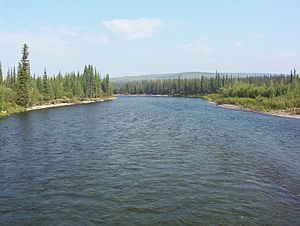Klondike River facts for kids
Quick facts for kids Klondike River |
|
|---|---|

Klondike River crossing Dempster Highway
|
|
| Country | Canada |
| Territory | Yukon |
| Physical characteristics | |
| Main source | Ogilvie Mountains |
| River mouth | Yukon River Dawson City, Yukon, Canada 64°03′08″N 139°26′27″W / 64.05222°N 139.44083°W |
| Length | 160 km (99 mi) |
The Klondike River is a tributary of the Yukon River in Canada that gave its name to the Klondike Gold Rush. The Klondike River has its source in the Ogilvie Mountains and flows into the Yukon River at Dawson City.
The original name for Klondike is a mispronunciation of the Hän names Tr’ondëk or Kl’o ndëk. Tr’ondëk refers to special rocks used to hammer in salmon fishing weirs at the mouth of the river. Kl’o ndëk means “water flowing through grass”. The banks of the Klondike River were once lush and grassy from the mouth to the headwaters. Years of dredging have torn up much of the lower valley.
Gold was discovered in tributaries of the Klondike River in 1896, which started the Klondike gold rush.
Prior to the construction of the Klondike Highway in the 1950s, the Klondike River was the main travel route in the valley. When the water flowed, people travelled along the river using birch bark canoes, moose skin boats and rafts. When the ice formed, people travelled by foot, using snowshoes and dogs to pack supplies.
Today there are many recreational activities in the Klondike River area. In summer people can travel down the river in canoes and rafts. In winter, people can snowshoe, ski and also snowmobiling.The Klondike River is a rich environment for hunting, fishing, berry picking, gold mining and recreational activities.
Images for kids
-
Klondike River (left) flowing into the Yukon River (top and right) at Dawson City
-
Klondike River crossing Dempster Highway (downstream)
See also
 In Spanish: Río Klondike para niños
In Spanish: Río Klondike para niños




